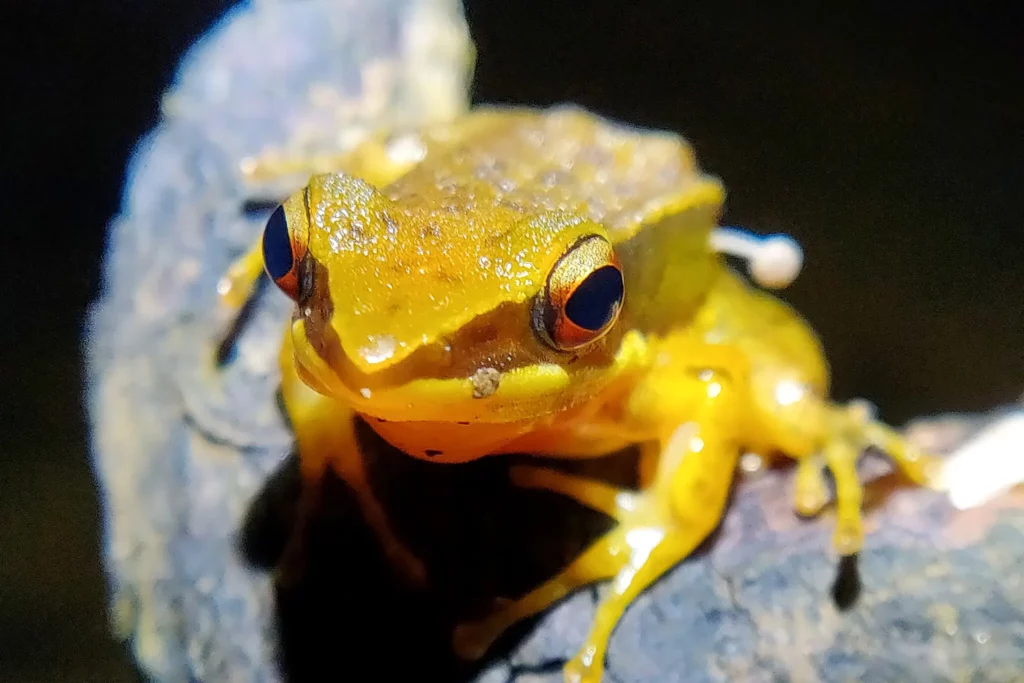
In the lush, rain-soaked foothills of the Western Ghats in India, a group of researchers affiliated with the World Wildlife Fund set out on a daring nature expedition. Their mission was simple: to explore the rich biodiversity of amphibians and reptiles in this renowned hotspot. However, what began as a herpetological quest soon morphed into an extraordinary discovery that blurred the lines between flora and fauna.
A mysterious mushroom growing on live tissue
As they navigated the verdant landscape, dodging leeches along the way, the team’s attention was quickly captured by a peculiar sight—a frog with a tiny mushroom sprouting from its side. They couldn’t believe their eyes.
The creature in question is a Rao’s intermediate golden-backed frog (Hylarana intermedia), a species native to this biodiverse region. The researchers took pictures of the itty-bitty fungal limb emerging from the frog’s flank and quickly shared their findings in a new study that appeared in the journal Reptiles and Amphibians.
Just like bacteria, you’ll find countless strains of fungi living inside most creatures. A 2010 study, for instance, found that anywhere from 9 to 23 strains of fungal species could be found in any one person’s mouth. Fungi are also commonly found on the surface of human skin, feeding on sparse nutrients. Some of these species are symbiotic, helping ramp up the immune system against pathogens. Other species on the skin cause fungal infections, some of the most common including athlete’s foot, jock itch, ringworm, and yeast infections.
However, you’ll never see a mushroom (the fleshy fruit of fungi) sprouting from a person’s arm. Mushrooms only emerge when the mycelia—threadlike structures akin to a plant’s roots—absorb sufficient nutrients, which are typically very poor on the surface of the skin. This is the first time that scientists have seen a mushroom growing on live animal tissue.

The researchers who first made the discovery didn’t collect the animal. Without the frog or mushroom in hand for further study, the exact nature of this fungal growth remains speculative. Could the mycelia have penetrated the amphibian’s skin, or was this a superficial growth?
More questions than answers
The discovery, later detailed in the journal Reptiles and Amphibians, sparked intrigue among the scientific community and citizen scientists alike. Images of the frog, shared online by Mr. Lohit, drew comparisons to bonnet mushrooms, a genus known as Mycena, which typically thrives on decaying wood. The occurrence of such a fungus growing from a living amphibian presented a baffling puzzle: How did this mushroom come to sprout from the frog? Is it benign or pathogenic?
Scientists don’t really know yet and have few means at their disposal to paint a clear picture with only a few photographs on hand.
The proposed Mycena-like mushrooms grow well in this setting. The humid, monsoon-fed forests of the Western Ghats provide an ideal breeding ground for such fungal growths, with their combination of moisture and organic matter. Still, without a comprehensive study, the impact of this fungal inhabitant on the frog’s health remains unknown.
Although this mushroom outgrowth may be benign, other fungi are much less forgiving. Chytridiomycosis, an infection caused by a fungus called Batrachochytrium dendrobatidis has been linked to massive declines in populations (over 90%) and extinctions of hundreds of amphibian species.
Only further study, and maybe a second sighting, could ease the speculation about this highly unusual specimen.






